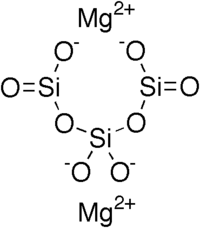Magnesium trisilicate
 | |
| Names | |
|---|---|
| Preferred IUPAC name
Dimagnesium dioxido-bis[(oxido-oxosilyl)oxy]silane | |
| Identifiers | |
| 14987-04-3 | |
| ChEMBL | ChEMBL1200428 |
| ChemSpider | 4470779 |
| |
| Jmol-3D images | Image Image |
| PubChem | 5311266 |
| |
| Properties | |
| Molecular formula |
Mg2O8Si3 |
| Molar mass | 260.86 g·mol−1 |
| Appearance | White crystals |
| Odor | Odourless |
| Hazards | |
| R-phrases | R36, R37, R38 |
| Except where noted otherwise, data is given for materials in their standard state (at 25 °C (77 °F), 100 kPa) | |
| Infobox references | |
Magnesium trisilicate is an inorganic compound that is used as a food additive. The additive is often employed by fast food chains to absorb fatty acids and remove impurities that form in edible oils during the frying process.
Health effects
On March 12, 2007, Chinese health authorities seized and halted the use of magnesium trisilicate at Shaanxi Province KFC franchises, suspecting it to be a possible carcinogen.[1] As a response, China's Ministry of Health conducted tests at six outlets of KFC.[2] The results showed chemicals in the cooking process at KFC restaurants in the country were not harmful.[3] The Ministry of Health said tests showed that using the product to filter cooking oil had no apparent impact on health. Food scares regularly sweep the Chinese media.[4]
Magnesium trisilicate can be used as an antacid in the treatment of peptic ulcers. It increases the pH of gastric juice via a neutralisation reaction. It also precipitates colloidal silica, which can coat gastrointestinal mucosa conferring further protection.
It can also be used in oral pharmaceutical formulations and food products as a glidant. It is also used therapeutically as an antacid, and also for the treatment of ciprofloxacin overdose or toxicity.
References
- ↑ "Suspect additive found in KFC". Xinhua News Agency. March 12, 2007.
- ↑ "Chinese Health Ministry Okays KFC". Medindia. March 14, 2007.
- ↑ "China officials clear KFC". QSRweb. March 14, 2007.
- ↑ "China officials clear KFC after food scare". Reuters. March 13, 2007.
| ||||||